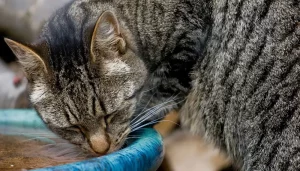Training can help you bond with your cat and reduce their boredom
Cats can be trained at any age. For fearful cats, bored cats, and energetic cats, learning tricks can be very beneficial. It is part of creating a stimulating environment for your pet’s mental and physical health. It stimulates their brains, motivates them, and creates a bond between you and your pet.
Training timid cats helps them cope by showing them how to control the outcome of their actions.
Positive Reinforcement
Positive reinforcement training means that desired behavior is rewarded while undesirable behavior is ignored. Sessions should be kept to a maximum of five minutes and your cat can choose whether or not to take part. You can skip the tricks section to jump straight into training. Instead, you can teach your cat “sit” and “spin” by using a treat or lure.
Reward & Treats
You can reward your cat with attention, play, affection, and/or a favorite toy. When your cat does something you like, reward him immediately. It is best to reward your cat within 1-3 seconds. As a reward, you should only give small quantities of food. You can break down treats into smaller pieces, and for lickable treats, just one to two spoonfuls will do.
Treats should not be more than 10% of a cat’s diet. Treats should not exceed 1-2 calories per treat if your cat is overweight. You can limit the amount of treats you give to cats who are obese. It’s good to know that cats who are very food-motivated will sometimes do tricks for individual kibbles even after their initial training.
Clicker Training is a Recommended Method
Clicker training is a method to train cats. The videos below are from CLICK, a cat training company. Although this is a positive method of training, it is not the only one. To train, you don’t necessarily need a clicker; instead, you can use your voice to repeat a word (like “good!”).
Clicker training: explanation of clicker training as positive reinforcement. It also explains how it differs from using treats to induce behavior. You can also use clicker train even if your cat doesn’t like clicking.
Priming the clicker: Teaching a cat how to associate clicking or any other sound with a reward
Start with these tips
- Targeting – Teaching a cat how to touch their nose with a target. This can be used to influence other behavior/movements later.
- You can teach sitting using a target stick or a treat.
- Spin – Teaching using a target stick. Some cats may need to break this down into smaller movements for training.
- Targeting can be used to train high fives, jumping through a hoops, jumping over jumps, weaving through poles or sitting pretty.
- You can also train your cat to come to you on a mat, bed, roll over and other tricks using the methods below.
- You can also use these videos to train other behaviors, such as forming a behavior through successive approximations or capturing a spontaneous behavior and getting a cat to change its position.
Tips, techniques, and troubleshooting
- Take it slow – you don’t have to hurry. If your cat becomes stuck on a step of a trick you’ll need to return to the beginning and continue working slowly. It may be necessary to add an intermediate step between them.
- Consistency is the key. You must reward your cat consistently.
- Evaluate your environment again. For cats to concentrate, they need calm environments. Your cat should have fun and keep sessions short.
- Treats are the best treats for your cat, especially when you’re just starting! Training your cat when they are hungry can be helpful.



